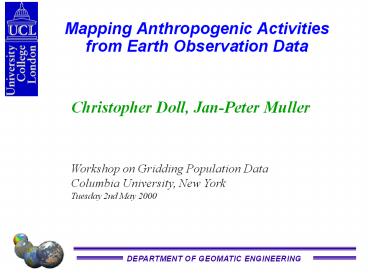Mapping%20Anthropogenic%20Activities%20from%20Earth%20Observation%20Data - PowerPoint PPT Presentation
Title:
Mapping%20Anthropogenic%20Activities%20from%20Earth%20Observation%20Data
Description:
Christopher Doll, Jan-Peter Muller. Workshop on Gridding ... Doll & Muller (RSS99) estimated country-level urban population for 12 countries to within 97 ... – PowerPoint PPT presentation
Number of Views:72
Avg rating:3.0/5.0
Title: Mapping%20Anthropogenic%20Activities%20from%20Earth%20Observation%20Data
1
Mapping Anthropogenic Activities from Earth
Observation Data
Christopher Doll, Jan-Peter Muller Workshop on
Gridding Population Data Columbia University,
New York Tuesday 2nd May 2000
2
Overview
- Scientific Justification
- Mapping Socio-economic parameters from Night-time
Data - Night-lights and Datasets over the UK
- Initial Conclusions
- Future Research Directions
3
Scientific Justification
- Global population remains poorly defined across
the Earths surface (Clark Rhind, 1992) - Human activity affects both the atmosphere and
the surrounding terrestrial/coastal environs - Global change has many manifestations and effects
on human life - flooding and landslides (Venezuela 10/99,
Mozambique 2/2000) - Thousands of people killed and displaced
- Storms over Western Europe 12/99, US Hurricanes
- Billions of insurance loss
- Satellite monitoring provides the best
opportunity to survey changing population
rapidly, albeit indirectly through land use
changes
4
Mapping Anthropogenic Parameters from DMSP-OLS
Data
- Doll, Muller Elvidge. Ambio May 2000
- Global relationships established by country level
correlation of lit area and CO2 emissions (CDIAC) - Lit area remapped from 30 to 1? with a lit
value in each cell - Relationship applied to new 1? map with areal
approximation into 10 latitudinal zones
5
Mapping CO2 from DMSP-OLS
- Global Image gridded to 1º and lit figure
assigned. - Result compared with CDIAC 1995 map
- Similar distribution, but magnitudes are lower
than CDIAC 25
kT of Carbon
6
CO2 Emission difference Map CDIAC - OLS
7
Total Lit Area (by country) vs. Purchasing Power
Parity GDP provided by WRI (1995)
8
Mapping Economic Activity
- Purchasing Power Parity GDP used as a more equal
measure - GDP map uses night-lights to distribute
relationship at 1 resolution - Total of global economy figure of 22.1 trillion
cf. 27.7 trillion Intl , from WRI figures
9
Night-lights within the UK
- Doll Muller(2000) ISPRS2000, July 2000
Amsterdam - Bartholomews 1250 000 road network map
- 22 road classes grouped by road type in standard
road atlases - Institute of Terrestrial Ecology (ITE) land cover
map (25 classes) at 25m derived from Landsat
imagery - 1km summary product giving coverage of each
class - Urban and Suburban rural infrastructure
classes of interest - Gridded 200m Population data from UK government
1991 census
10
Night-lights and the UK Road Network(Bartholomew
s 1250 000)
Radiance x10-10 W.cm2.?m-1.sr-1
11
Night-lights and Road Density
- Non-primary A-Roads dominate in urban areas
- B-Roads also peak in city centres
- No comprehensive central list exists of lit road
sections for the UK - Assumes all roads are lit
- Will make road density map and compare to gridded
population
12
Night-lights and other parameters over London at
1km
Suburban/Rural infrastructure (ITE)
Gridded Population (1991 census)
Population.km-2
coverage
Urban (ITE)
DMSP-OLS Radiance Calibrated Night-lights
Radiance W.cm2.?m-1.sr-1
60 km
65 km
13
Land cover-Population Relationships
1km pixels for the UK
- 43 of urbansuburban land cover ? 2000
people/km2 ? DCW urban layer - Less obvious relationship with radiance
- Single threshold overestimates some settlements,
but omits others - Doll Muller (RSS99) estimated country-level
urban population for 12 countries to within 97 - Potential to examine population morphology of
urban centres - All distributions appear to behave like
self-critical phenomena
Log Radiance
Log Radiance
European Cities
Log Suburb. cover
14
Population density cf. DMSP-OLS radianceWhich is
best to map urban areas?
Population.km-2
15
Initial Conclusions
- Mapping urban area from night-time data has
significant advantages over other RS data sources - But DMSP-OLS data is coarse, 2.7km re-sampled to
1km may not be fine enough - Need to distinguish between urban and rural light
sources - Consider the use of population density to map
urban area - Population mapping with radiance calibrated data
appears to offer a lot of potential - Data set flexible to a much wider range of
methodologies
16
Future Research Directions
- Trial acquisition of night-time data from
NASA-EOS (Terra) sensors planned in May/June - MODIS (250m sensitive band)
- MISR (possible analysis of directional effects)
- Assess the potential and limitations in accuracy
and reliability of city lights to map global
population distribution within urban areas
including - How Temporally stable are coefficients?
- Next step to try to extrapolate 1km distributions
rather than just produce aggregated
(country-level) statistics - Develop better classification techniques for
night-light data - Adaptive Pixel allocation algorithm (ADAPIX)
- Assign urban/rural classification based on
pixels position within a cluster
(country-dependent)
17
Modelling approachAdaptive Pixel Allocation
Algorithm
- Multiple orbit compositing can cause small urban
areas to look larger - Pixels of equal, low radiance can occur in
different locations, though unlikely to have same
population density - Algorithm will assess pixel class based on the
size of its cluster and distance from centre
Low radiance pixel near the centre of town
Low radiance pixel out of town
175 km
18
Thank you for your time Christopher Doll
cdoll_at_ge.ucl.ac.uk
Los Angeles at night- 1988































